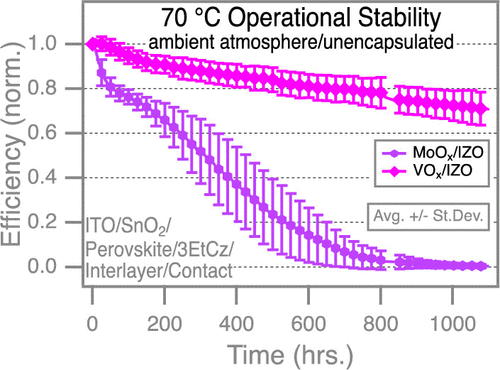当前位置:
X-MOL 学术
›
ACS Energy Lett.
›
论文详情
Our official English website, www.x-mol.net, welcomes your
feedback! (Note: you will need to create a separate account there.)
The Molybdenum Oxide Interface Limits the High-Temperature Operational Stability of Unencapsulated Perovskite Solar Cells
ACS Energy Letters ( IF 19.3 ) Pub Date : 2020-06-15 , DOI: 10.1021/acsenergylett.0c01023 Tracy H. Schloemer 1, 2 , James A. Raiford 3 , Timothy S. Gehan 2 , Taylor Moot 2 , Sanjini Nanayakkara 2 , Steven P. Harvey 2 , Rosemary C. Bramante 2 , Sean Dunfield 2, 4 , Amy E. Louks 2 , Annalise E. Maughan 2 , Lyle Bliss 2, 5 , Michael D. McGehee 2, 4, 5 , Maikel F. A. M. van Hest 2 , Matthew O. Reese 2 , Stacey F. Bent 3 , Joseph J. Berry 2 , Joseph M. Luther 2 , Alan Sellinger 2
ACS Energy Letters ( IF 19.3 ) Pub Date : 2020-06-15 , DOI: 10.1021/acsenergylett.0c01023 Tracy H. Schloemer 1, 2 , James A. Raiford 3 , Timothy S. Gehan 2 , Taylor Moot 2 , Sanjini Nanayakkara 2 , Steven P. Harvey 2 , Rosemary C. Bramante 2 , Sean Dunfield 2, 4 , Amy E. Louks 2 , Annalise E. Maughan 2 , Lyle Bliss 2, 5 , Michael D. McGehee 2, 4, 5 , Maikel F. A. M. van Hest 2 , Matthew O. Reese 2 , Stacey F. Bent 3 , Joseph J. Berry 2 , Joseph M. Luther 2 , Alan Sellinger 2
Affiliation

|
We report on the improved operational stability of unencapsulated perovskite solar cells (PSCs) aged in an ambient atmosphere at elevated temperatures (70 °C) for >1000 h under constant illumination and bias at 30–50% relative humidity. We identify a previously unseen interfacial degradation mechanism concerning the use of a MoOx interlayer, which was originally added to increase operational stability. Specifically, the hole-transport layer/MoOx interface buckles under illumination at 70 °C, which leads to delamination and rapid losses of short-circuit current density corresponding to an average t80 of ∼55 h. By judiciously evaluating various hole-transport layers, interlayers, and contacts, we find that replacing the MoOx with a VOx interlayer, regardless of the other components in the solar cell, alleviates this buckling issue due to its higher activation barrier toward crystallization, leading to significant gains in PSC operational stability. Unencapsulated devices aged in an ambient atmosphere with a VOx interlayer retain 71% of their initial PCE on average after constant illumination and bias at 70 °C for 1100 h (t80 ∼ 645 h). Currently, this is the highest temperature reported for the operational stability of unencapsulated n-i-p PSCs aged in air. Identification of a new facet of the complex degradation mechanisms in PSCs will allow for targeted acceleration testing to speed the deployment of low-cost, long-lasting electricity generation under realistic operating temperatures.
中文翻译:

氧化钼界面限制了未封装钙钛矿太阳能电池的高温操作稳定性
我们报告了在恒定的光照下和在30%至50%的相对湿度下保持不变的情况下,在高温(70°C)下在环境大气中老化超过1000小时的未封装钙钛矿太阳能电池(PSC)的操作稳定性得到了改善。我们确定了关于MoO x中间层的使用的以前看不见的界面降解机制,最初是为了增加操作稳定性而添加的。具体来说,空穴传输层/ MoO x界面在70°C的光照下弯曲,这导致分层和短路电流密度的快速损耗,相当于平均t 80约为55 h。通过明智地评估各种空穴传输层,中间层和接触点,我们发现替换了MoO x使用VO x夹层的太阳能电池,无论太阳能电池中的其他组件如何,都可以缓解这种弯曲问题,因为它具有更高的结晶激活壁垒,从而大大提高了PSC的操作稳定性。老化与VO环境气氛未被包封的装置X层间在70℃下保持其上的恒定照明和偏压后平均初始PCE的71%为1100 H(吨80〜645小时)。目前,这是在空气中老化的未封装压区PSC的操作稳定性所报告的最高温度。确定PSC中复杂的降级机制的新方面将允许进行针对性的加速测试,以加速在实际工作温度下低成本,持久发电的部署。
更新日期:2020-07-10
中文翻译:

氧化钼界面限制了未封装钙钛矿太阳能电池的高温操作稳定性
我们报告了在恒定的光照下和在30%至50%的相对湿度下保持不变的情况下,在高温(70°C)下在环境大气中老化超过1000小时的未封装钙钛矿太阳能电池(PSC)的操作稳定性得到了改善。我们确定了关于MoO x中间层的使用的以前看不见的界面降解机制,最初是为了增加操作稳定性而添加的。具体来说,空穴传输层/ MoO x界面在70°C的光照下弯曲,这导致分层和短路电流密度的快速损耗,相当于平均t 80约为55 h。通过明智地评估各种空穴传输层,中间层和接触点,我们发现替换了MoO x使用VO x夹层的太阳能电池,无论太阳能电池中的其他组件如何,都可以缓解这种弯曲问题,因为它具有更高的结晶激活壁垒,从而大大提高了PSC的操作稳定性。老化与VO环境气氛未被包封的装置X层间在70℃下保持其上的恒定照明和偏压后平均初始PCE的71%为1100 H(吨80〜645小时)。目前,这是在空气中老化的未封装压区PSC的操作稳定性所报告的最高温度。确定PSC中复杂的降级机制的新方面将允许进行针对性的加速测试,以加速在实际工作温度下低成本,持久发电的部署。











































 京公网安备 11010802027423号
京公网安备 11010802027423号